Despite strong demand for rental housing in the Twin Cities, real estate developer Leanna Stefaniak said her firm has slowed down plans for new apartments.
The main obstacle has been high interest rates, Stefaniak said in early September. “The cost to fund right now is really expensive and, at least for us, that has caused us to pause.”
While construction of new multifamily housing around the country remains relatively strong, activities that precede construction suggest the industry is headed toward a significant slowdown.
A key indicator is the number of multifamily housing units receiving building permits from local governments, as reported by the U.S. Census Bureau. Between January and October this year, this number fell by 38 percent in the Ninth District compared with the same period last year. The decrease was more severe in the Twin Cities metropolitan statistical area, Stefaniak’s primary market, with permitted units down by 52 percent.
Nationwide, permitted units were down 17 percent.
The Federal Reserve has been lowering its benchmark interest rates since mid-September. But Stefaniak said in early January that rates remain higher than many developers are comfortable with. Even if rates keep falling though, she and others in the industry don’t expect apartment construction to rebound right away. It takes two years or more from when a developer initiates an apartment project to when those apartments are available for lease; construction alone takes 18 to 24 months after a permit is issued. It also takes time for new renters to absorb the new supply.
Housing supply is connected to housing affordability, and a construction slowdown could exacerbate existing affordability challenges.
What made the boom
The recent slowdown in permitting follows an intense period of growth during the pandemic (Figure 1), when the Fed’s benchmark interest rate fell sharply in spring 2020.
By 2022, the number of multifamily units permitted in the Ninth District had peaked at 27,000. (This article focuses on apartment construction, so only units in buildings with five or more units are counted. Some of these units are condominiums, but the vast majority are for rent.) That peak is a 51 percent increase over 2019. It’s also significantly higher than the 35 percent increase over the same period nationwide.
Cecil Smith, president of the Minnesota Multi Housing Association, said demand for apartments was as strong as before the pandemic, but supply was supercharged by the low interest rates.
Throughout 2019, the federal funds rate, which influences interest rates on construction loans across the nation, reached as low as 1.55 percent. In spring 2020, it fell to 0.05 percent and mostly stayed below 0.1 percent for the next 23 months.
But how developers in different states and markets responded to those rates depended on a variety of factors that affect demand.
Nationwide, industry observers say a growing number of upper-income renters have delayed homebuying due to high home prices. That market has expanded rapidly as a result. Developers have been especially responsive because, as construction costs have grown, the most financially feasible type of apartments are high-end ones.
Between 2019 and 2022, the number of renter households with annual incomes of $100,000 or more grew by 32 percent nationwide compared with the 3 percent growth of all renter households, according to census data.
In the Ninth District, upper-income renter households grew by 55 percent. There was a lot of variation among states, though, from 1 percent in North Dakota to 27 percent in Minnesota to 61 percent in South Dakota.
In Montana and South Dakota, many of these renters are part of a population increase that began in the pandemic.
Paul TenHaken, the mayor of Sioux Falls, South Dakota’s largest city, said the city has long attracted new residents from communities within about 200 miles, but it grew faster at the start of the pandemic with new residents coming from all over the country. He said many were drawn to the state because it never locked down during the pandemic, and because of its low taxes.
The new residents are driving apartment construction because homeownership costs are still too high for many, TenHaken said. “People who were maybe wanting to get to a home are staying in an apartment a little bit longer.”
In Minnesota, the construction boom has been ongoing for at least half a decade prior to interest rates falling, driven mostly by the Twin Cities market. Lower rates made the boom bigger.
According to John Patterson, who leads Minnesota Housing’s research division, the boom is the result of developers playing catch-up with the market. He said financial challenges that began before the Great Recession caused builders to underproduce new housing from 2006 to about 2016.
Throughout this time, household numbers were growing, he said, leading to low vacancies and rising rents that eventually led developers to increase production.
The slowdown
Since peaking in 2022, the number of permitted multifamily units has been in decline in the Ninth District and across the nation.
Demand for new apartments has not slackened. If anything, high interest rates have caused even more upper-income renters to delay homeownership. But interest rates have increased significantly—the fed funds rate went from 0.08 percent in early 2022 to 5.33 in mid-2023—causing developers to cut production.
“There’s still demand, but now it’s twice as expensive to service your debt,” Smith said. Along with higher construction costs and operating costs, that higher debt makes it harder for a project to pencil out, he said.
As of November 2024, the fed funds rate was 4.64 percent, well above what it was during the peak years.
Between January and October 2024, the number of permitted multifamily units fell 32 percent nationwide compared with the same period in 2022, the peak of the construction boom, and 6 percent compared with 2019, the year before low interest rates ignited that boom (Figure 2).
Throughout the Ninth District, permitted units fell 56 percent compared with 2022 and 25 percent compared with 2019.
Most district states reported a similar decrease in permitting activities from 2022. But, compared with 2019, Montana and South Dakota activities remain significantly higher at 48 percent and 111 percent, respectively, reflecting population growth since the pandemic. Permitting data from Missoula and Bozeman, in Montana, and Sioux Falls and Rapid City, in South Dakota, show this trend clearly (Figure 3).
Minnesota activities have decreased by 42 percent, driven almost entirely by the Twin Cities. Excluding that market, the rest of Minnesota grew 27 percent. Duluth and Rochester have been especially active.
Patterson said he had earlier forecast a slowdown around this time because developers were on track to catch up with the market. Demand is likely growing because high interest rates have made homeownership more challenging, he said, but supply is much closer to demand now than it had been a few years ago.
The expected rebound
The Federal Reserve’s recent change in direction with interest rates was greeted with relief by developers and real estate investors around the country, with many expecting multifamily housing to benefit the most.
In the Twin Cities, Stefaniak said she expects permit numbers to increase because the demand is there. “We still have a gap in terms of the number of units available and the number of people that need that. There’s still a supply-demand issue. We need more supply to fill those needs.”
One challenge for developers is that demand among upper-income renters appears to not have grown as quickly as the supply of high-end apartments thanks to the construction boom. In fact, Smith said, many of these apartments are now offering incentives to new renters.
For renters, these trends may make more apartments affordable for more people or at least limit rent increases.
Interest rate cuts may have a stronger effect in markets with above-average growth like Sioux Falls, where supply is still catching up with demand.
Jake Christensen, president of Christensen Development in Des Moines, Iowa, said he’s watching interest rates as he plans a new office and apartment complex in downtown Sioux Falls. The office space was viable before the recent interest-rate cut, but his firm is still working on plans for the 230 to 300 apartment units.
An important factor is where interest rates land in a year when he begins seeking financing, he said. If the rates and variables such as rent aren’t favorable, he said, the firm would have to reevaluate the apartment plans.
Tu-Uyen Tran is the senior writer in the Minneapolis Fed’s Public Affairs department. He specializes in deeply reported, data-driven articles. Before joining the Bank in 2018, Tu-Uyen was an editor and reporter in Fargo, Grand Forks, and Seattle.






